The Western Wall
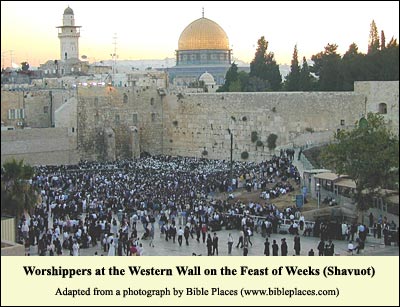
If we come here in the morning on Sabbath (or on Monday or Thursday, the old market days) we can witness groups of worshippers reading from scrolls of the TorahThe word torah or "teaching" refers in particular to the first five books of the Bible. For ceremonial reading, these are handwritten on parchment in a scroll. Each week on Sabbath Jews read a section, completing the Torah in a year. A part of the weekly section is also read on Mondays and Thursdays. In Orthodox Judaism, a quorum of ten Jewish men (a minyan) is required for the ceremonial, public reading. Reform and some Conservative Jews do not discriminate between the sexes in matters of ritual, but these movements are small in Israel. . Many services may be going on at once: a quorum of ten suffices. (A minyan.In orthodox Judaism, a minyan – a quorum of ten Jewish males who have undergone initiation (Bar Mitzvah) – is required in order to hold a full worship service, including the public Torah reading, the priestly benediction, and the recitation of the prayer known as Kaddish (chanted, for example, by mourners). A biblical sentence, "God stands in the divine assembly" (Psalms 82:1) led the ancient rabbis to comment that if ten men pray together, God's presence (His shekhinah) hovers over them. (Avot 3.6). ) In some of these services, a thirteen-year-old boy will be responsible for the Torah reading. He is a bar mitzvah, literally a "son of the commandment." By this act of publicly chanting the Torah portion, he is undergoing his initiation into manhood. It is a nerve-racking affair: He hasn't the vowel signs or the musical notes in front of him, but older men, who have both in their books, stand ready to correct him. (Is there a "a daughter of the commandment?" She would be called a bat mitzvah.In orthodox Judaism, which predominates in Israel, there is no special initiation ceremony for the passage from girlhood to womanhood. In rites of passage, even Israel's non-religious Jews follow orthodox practice. To try to hold a Bat Mitzvah ceremony at the Western Wall would cause a riot. An Israeli girl sometimes has a party at the age of 12, but for the most part that is all. In America, where the Reform and Conservative movements are strong, girls do go through a Bat Mitzvah. Orthodoxy, however, retains the patriarchal character of traditional Judaism.) The ceremony is not attested before 1400 AD, although the Mishnah, 1200 years earlier, gave the age of 13 as that for observing the commandments.
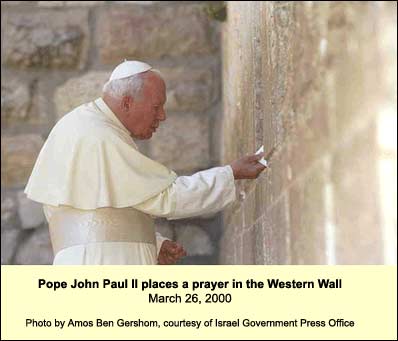
On a Bar Mitzvah day, we can see the joy of families as their boys become men. For the last 34 years, indeed, more joy than wailing has been heard at the Western Wall. The turning point came in June 1967, when Israel conquered the Old City. Since then the Jews have dropped the name, "Wailing Wall." Gentiles too may approach the stones. Solomon made provision for the "foreigner" when he dedicated the Temple ( 1 Kings 8:41-43 1 Kings 8:41-43:“Also concerning the foreigner who is not of Your people Israel, when he comes from a far country for Your name’s sake (for they will hear of Your great name and Your mighty hand, and of Your outstretched arm); when he comes and prays toward this house, hear in heaven Your dwelling place, and do according to all for which the foreigner calls to You, in order that all the peoples of the earth may know Your name, to fear You, as do Your people Israel, and that they may know that this house which I have built is called by Your name.” ). Certain rules should be observed. (See Logistics.) Since 1929, the Jews have separated women from men here, as in orthodox synagogues. Women go to the right, men to the left. On any day but Sabbath, one may write a prayer and tuck it into a crevice.
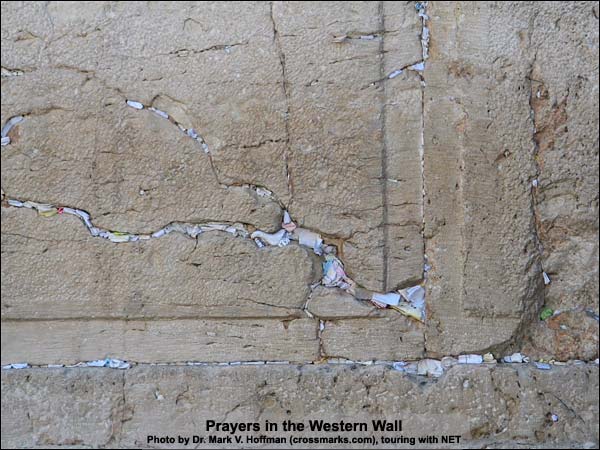
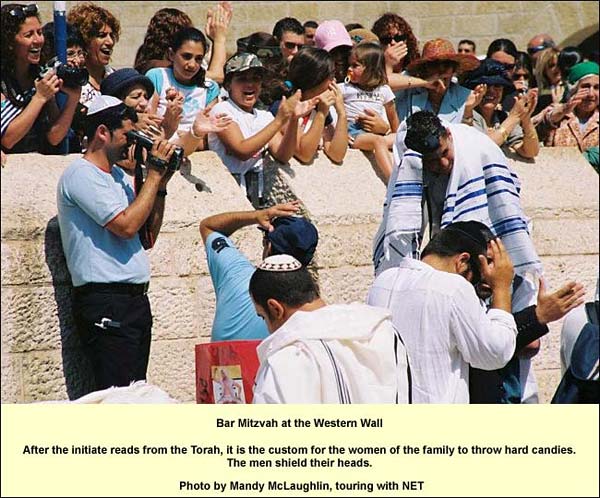
{mospagebreak title=Archaeology of the Wall} The Great Walls around the Temple: Why and how Herod built them (but did he?) In 2011, archaeologists Eli Shukron and Ronny Reich dug down to bedrock near the SW corner of the Temple Mount. They discovered various rock-cut installations that had belonged to buildings earlier than the temple Herod built. One of them was a ritual bath, miqveh. The builders had filled it, topped it with three large flat stones, and laid the wall's first course over part of it. The archaeologists of 2011 removed fill from the half of the mikveh that was not beneath the wall's foundation stones, rather west of them. They found three clay oil lamps that were typical of the 1st century AD. They also found coins, of which the latest four had been minted by the Roman prefect Valerius Gratus in 17 - 18 AD. (For an account by the Israel Antiquities Authority, see here.) The excavators concluded that this section of the Western Wall could not have been built under Herod, who died in 4 BC. This conclusion, which received much publicity worldwide, would imply a post-Herodian date not only for the southern end of the Western Wall, but also for the royal portico, of which Josephus wrote,Antiquities XV Ch. 11, Par. 5 "this cloister deserves to be mentioned better than any other under the sun." With its 162 huge pillars, each having the girth of three men with extended arms, it stretched the length of the southern wall (920 feet). We would also have to redate the Hulda Gates and the grand staircase. All this redating would undermine Josephus' account,Antiquities XV, Chapter 11, Paragraphs 3, 5, and 6; see also his The Jewish War I Ch. 21 Par. 1 for he tells us that Herod celebrated the completion of the temple, including the royal portico. Finally, one may question whether so huge a structure could have been built during the rule of a procurator. And why, in such a case, would Josephus have called it "royal," given that Herod was Judaea's last king? If the portico's funder had been a Jewish ruler, namely, Herod Agrippas (40 - 43 AD) or his son Agrippas II, surely Josephus, born in 36 AD, would have known as much and would not have credited their forebear. Admittedly, we read in John 2:20 that the construction of the temple, which began ca. 20 BC, took 46 years, and Josephus reportsAntiquities, Book XX, Ch. 9, Par. 7that it was completed only in 63 AD, when Agrippas II had the city repaved in order to provide jobs for the 18,000 workers whom the completion had left idle. (As often with Josephus, one suspects that a copyist added a zero to his demographic data.) But we have always had these passages, and they never stopped us from attributing the main structures to Herod, including the royal portico. The question is whether the coins of Gratus add enough to justify a redating. These coins, as said, were not found under the wall's foundation stones. In a recent comment, Leen Ritmeyer notes: "Actually the coins prove nothing at all, as the mikveh only project[s] a few centimeters under the wall. The coins came probably from a later repair." For instance, the street beside the wall shows no sign of use, so it was probably one of those that were repaved by order of Agrippas II, seven years before the destruction. Given the doubts about the proposed re-dating, I shall continue to assume that the temple's main structures were Herodian, including the royal portico and the outermost southwest corner. This assumption guides the following text. When Herod persuaded the people to let him tear down and rebuild the Temple, starting around 20 BC, he designed an esplanade of 35 acres (144,000 square meters). Thus it could accommodate Jerusalemites and pilgrims by the hundreds of thousands. In recent times, during the month of Ramadan, 400,000 Muslims have been known to gather on the mount, which they name the Haram al-Sharif. Herod's method was to erect huge retaining walls, fifteen feet thick, beyond the earlier ones. Between old walls and new, the workers stacked vaults, evening the surface with dirt and surmounting all with a platform. Because the new walls were so massive, the Temple enclosure could serve as a fortress, as it did during the first great revolt against Rome. Decades after the Romans destroyed it, some group - probably the Romans still - battered down the parts that stood above the platform. They set their rams inside, slamming outward. On reaching floor-level they stopped. In the excavation near the southwest corner of the western wall, the archaeologists have left a section of a street undisturbed. Here we can see the stones of the upper courses lying where they fell.
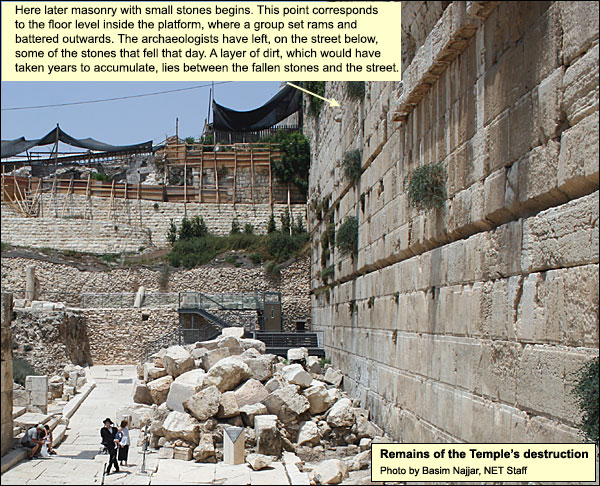
If we stand in the Western Wall plaza looking east, the seven lowest courses we see (including a fraction of one) belong to the same retaining wall as the one in the photo above, only further north. They are distinguishable by their margins (as you can see more clearly in the photo above). The top of the uppermost Herodian course corresponds to the level of the platform inside, where the batterers set their rams. The four courses above it, lacking margins (see picture below), date to repairs by the Arabs (Umayyads) in the 7th-8th centuries, when they built the al-Aqsa Mosque and the Dome of the Rock . The smaller stones above these are from later repairs.
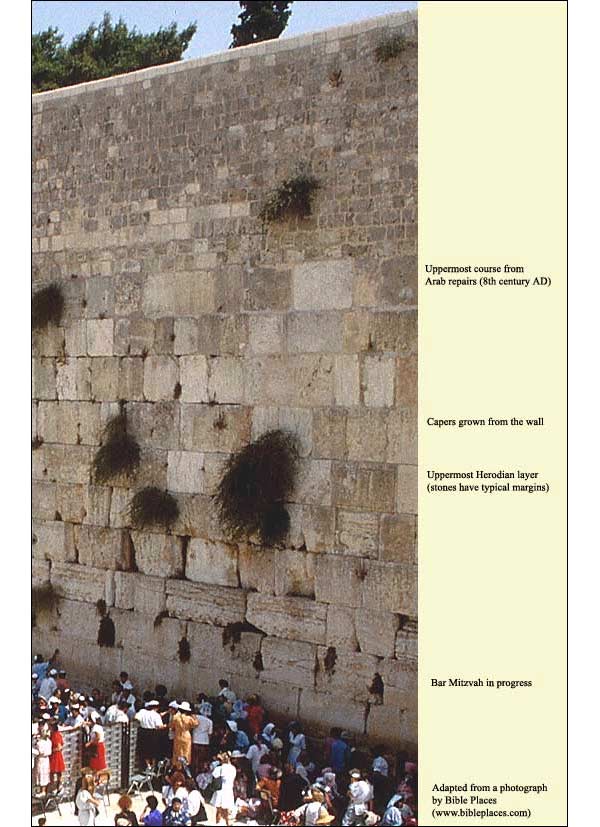
In this act of looking, however, we are standing about 30 feet higher than the Herodian street. There are another 19 Herodian courses beneath the current plaza, 8 of them consisting of dressed stones down to the Herodian street level and beneath them, not meant to be seen, 11 courses of stones with lumpy bosses, extending down to bedrock (How do we know?)In the late 1860's, the British explorer Charles Warren got permission from the Turkish sultan to dig shafts around the walls. He lowered himself into these, taking measurements and drawing. Just north of the Western Wall plaza, near Wilson's arch, he dug shafts down to bedrock. The street level has been established by modern excavations north and south of the Western Wall. See also Max Kuechler, Jerusalem: Ein Handbuch und Studienreisefuehrer zur Heiligen Stadt, Goettingen: Vandenhoeck & Ruprecht, 2007), p. 170. We are standing, that is, in the Cheesemakers Valley (Greek: tyropoeon), which has largely filled with debris through the centuries. Before the destruction of the wall, its total height (at this point) from bedrock to the top of the Temple's western porch was 125 feet.
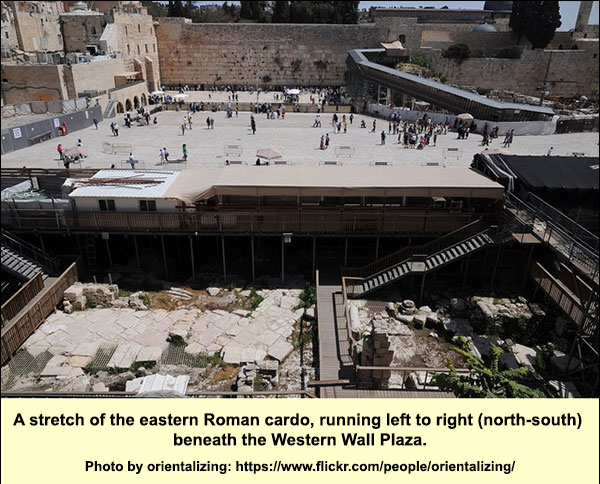
The entire western wall, 1590 feet long, formed part of the irregular rectangle composing the Temple complex. The blocks are of limestone. Most weigh between two and five tons. In the southwest corner, where greater strength was needed, the blocks are 36 feet long, 7 feet thick and the usual 3 feet high (the height of the limestone strata in the nearby hills). These stones at the corner weigh about 50 tons each. They continue, in crisscross fashion, beneath the ancient street to bedrock. They are not the largest. North of the prayer space, the archaeologists have dug a tunnel along the entire length of the western wall. At eye-level with another Herodian gate, in what is called the "master course," they discovered a block that is 45 feet long and 11 feet high, with a thickness estimated at between 11.5 and 15 feet. They estimate its weight at 570 tons. Nearby is another almost as big.
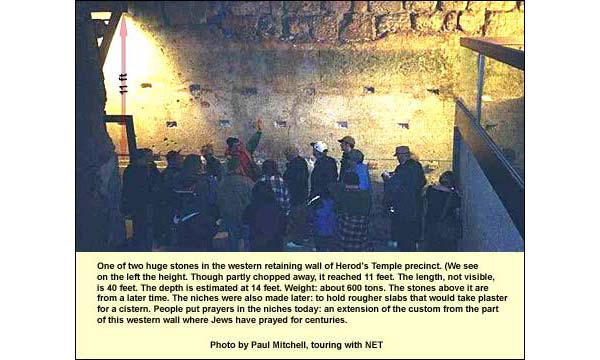
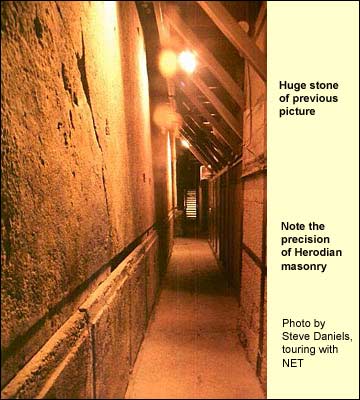
We do not know how the ancients managed to move these stones or set them so precisely. They had pulleys and levers, but 50 tons (not to mention 570!) is more than most modern construction cranes can handle. Perhaps they arranged the work so that they never had to lift a stone: they began quarrying at the level of the building site, to which they built a ramp; oxen dragged the stone on the ramp, using rollers; after they had set the first course, they quarried from a higher point and raised the ramp. Yet this, no doubt, is easier said than done! Nor does it account for the remarkable precision. Why did Herod call for such enormous stones? First, because he wanted to achieve stability without cement. The Romans had developed a high-grade mortar, using lime and volcanic ash. To get lime they had to burn limestone, and the fires required a great deal of wood. But wood is and was scarce in this country. People here had developed the craft of building dry walls. According to an estimate by Ben-DovMeir Ben-Dov, In the Shadow of the Temple. Jerusalem: Keter, 1985. (p. 89), if Herod had chosen to use smaller stones bound by cement, he might have made it equally strong, but at the cost of a hundred square kilometers of forest. Herod had another reason, too, to use big stones. This western wall was a crucial factor in his hold on power. As king of the Jews, he had a great deal against him. He had usurped the power from the HasmoneansThe Hasmoneans: family of Judah Maccabee ("the hammer") and his brothers, who revolted successfully against the Greek Empire in 167 BC. They purified and re-dedicated the Temple in Jerusalem, establishing the festival of Hanukah ("dedication"). They ruled till 63 BC, and their domain extended almost as far as King David's.. He was a collaborator with Rome, and so his dominion seemed to contradict the Jewish covenant faith. His Jewishness was greeted with skepticism by his subjects: his mother was a Nabataean Arab, and his Edomite paternal grandfather had converted to Judaism under pressure. Herod had, in other words, a problem of legitimacy. He had to cow his subjects into submission. This wall was part of the cowing. Josephus wrote: "... the city lay over against the temple in the manner of a theater" (Antiquities, XV 11.5).Antiquities = Josephus Flavius. Antiquities of the Jews. Translated by William Whiston. (Abbreviated in text as Antiquities.) That is, by Herod's time most Jerusalemites lived on the western hill, which is higher than the Temple Mount and slopes down into the Cheesemakers' Valley. Whenever they looked toward the Temple, then, they would see the western wall -- and Herod's mighty stones. Meir Ben Dov describes the effect: "Even though in objective terms you might be standing at a point level with or even higher than the Temple Mount esplanade, the towering walls created the optical illusion that the Temple compound was higher still. The further you descended toward the street bordering the Temple Mount, the greater the sensation of its height: as you walked down, the mountain seemed to grow higher before you." (Ben-DovBen-Dov, Meir. In the Shadow of the Temple. Jerusalem: Keter, 1985., p. 78.) Approaching, you would have made out more clearly the enormous size of the stones. Here the margins would have played their part, enabling you to distinguish them. Herod needed you to feel this awe. Every time you looked toward the Temple, he wanted you to sense his might and the might of Rome behind him -- and to connect all this with your God. Having no divine right, he tried to construct it in stone. In Mark (13:1-2) it is written: As he went out of the temple, one of his disciples said to him, “Teacher, see what kind of stones and what kind of buildings!”
Jesus said to him, “Do you see these great buildings? There will not be left here one stone on another, which will not be thrown down.”
{mospagebreak title=Destruction of Temple}
The Destruction of the Temple: A Historical Watershed
South of the Western Wall plaza, we can visit the excavations. Here we see the stones of the wall's upper courses, lying on the ancient street where they fell when (presumably) the Romans, standing on the Temple platform above, battered them down from inside. Doubt has been raised, however, as to whether this occurred during the destruction of 70 AD, because at the time the stones fell, the street pavement had accumulated a layer of dirt and clay between 3 and 5 centimeters thick (Kuechler, pp. 282, 295Max Kuechler, Jerusalem: Ein Handbuch und Studienreisefuehrer zur Heiligen Stadt, Goettingen: Vandenhoeck & Ruprecht, 2007))..
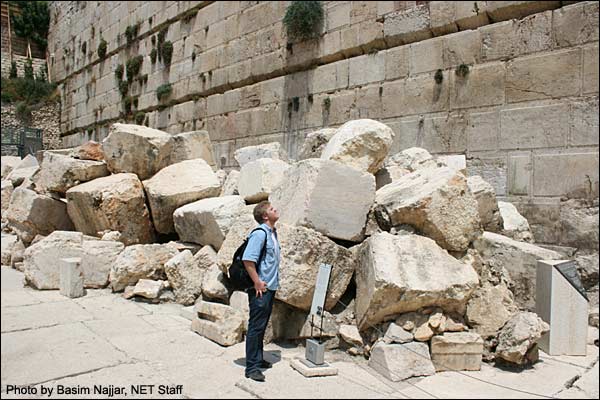
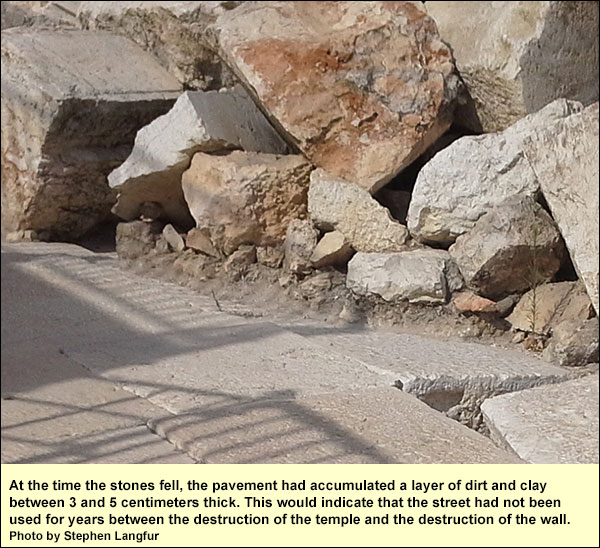
The destruction of the Temple! It is hard today to imagine the full extent of the trauma. It was not at all clear that Judaism could continue to exist without this institution. Most Jews were scattered among the nations, but the Temple had been their focus. It had been the only proper place for the sacrifices of thanks and atonement. It had been the main center for teaching and guidance. Now it was gone. How could the Jews, in dispersion, maintain their identity as Jews?
In the midst of this trauma, the great elaboration of Jewish law began that resulted a century later in the Mishnah and three hundred years after that in the Talmud -- laws which held the Jewish people together for two millennia without the land and without the Temple.
But the destruction resulted in another development as well. Judaism, until the moment these stones fell, had been an outgoing religion. The Jews thought of themselves as a chosen people, chosen for a purpose: to bring the nations back to the worship of the one true God. By them, the seed of Abraham, all the families of the earth were to be blessed. ( Genesis 12:3Genesis 12:3:“And I will bless those who bless you,And the one who curses you I will curse.And in you all the families of the earth will be blessed.” ). This people was to be a kingdom of priests ( Exodus 19:5-6Exodus 19:5-6:“Now then, if you will indeed obey My voice and keep My covenant, then you shall be My own possession among all the peoples, for all the earth is Mine; and you shall be to Me a kingdom of priests and a holy nation.’ These are the words that you shall speak to the sons of Israel.” ). The idea was not necessarily to convert the Gentiles to Judaism, but to persuade them to give up their idols. That is why the Gentiles were welcome in the synagogues. After the destruction of the Temple, however, the Jews had to worry about maintaining their own identity. The mission to the Gentiles went on the back burner, where it has remained to this day. And one of the things which the Jews felt they had to do was to exclude any groups that could cause division. Such a group was the sect of the Jewish Christians.
After the destruction of Jerusalem, then, the Jewish Christians could not take part in the Rabbinic revival of Judaism. Lacking the Temple, they were doomed to disappear, like the Sadducees. This left the field free for the Pauline brand of Christianity.
Were it not for this destruction, Judaism, the faith of Jesus, and Christianity, the faith in Jesus, might never have separated as decisively as they did.
The battered stones on the ancient street signify a major watershed in the history of the two religions. From here the two faiths parted.
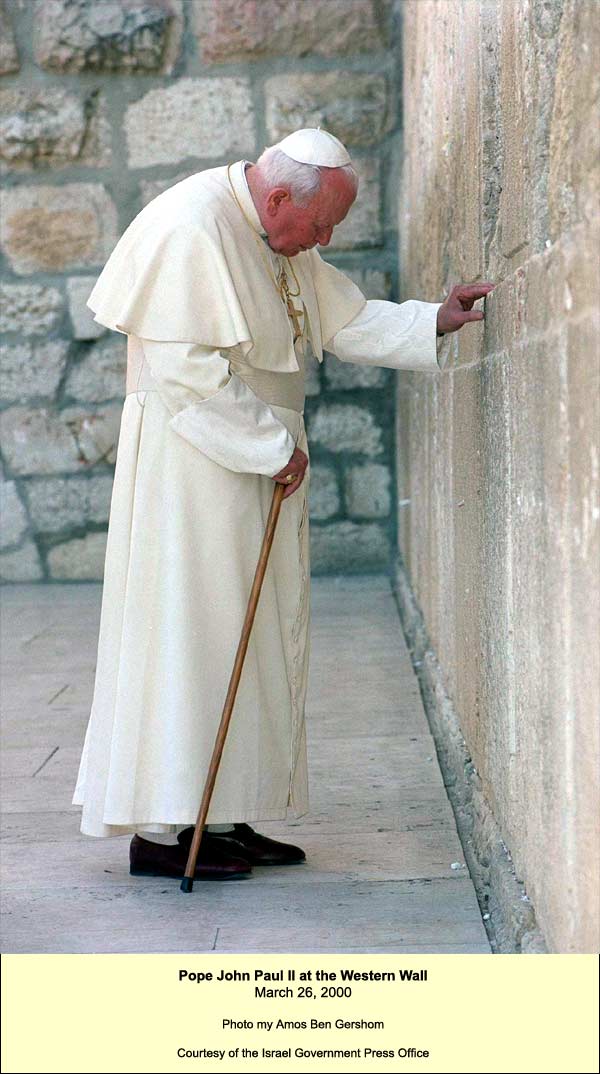
{mospagebreak title=Logistics}
Logistics for the Western Wall
1. There is a security check at all entrances to the plaza. Don't bring anything that might be construed as a weapon.
2. Admission to the prayer area is free. To arrange a visit in the archaeological tunnel, which extends northward for the whole length of the wall, call (02) 627-1333 or Fax (02) 626-4828. There is a fee. The Ophel Excavations at the Davidson Center, including the southwest corner and the Temple steps, are open for a fee on Sundays through Thursdays from 09:00 - 16:00, on Friday until 14:00 (but they close the area of the Temple steps on Friday at 11:00!). Phone: (02) 623-1221.
3. Modest dressShoulders covered, legs covered below the knees. is required in the plaza and in the archaeological tunnel.
4. On Sabbath and Jewish holidays (which start and end at sundown), all work in the plaza is forbidden, including photography, writing, recording, placing of a prayer in a crevice.
5. Men who approach the prayer area need head-covering. A paper cap is available.
6. Be prepared for the possibility that a beggar may approach you at the wall. Or someone may bless you and expect reimbursement. There is no obligation.
7. There is no shade.
8. There are drinking fountains and rest rooms.